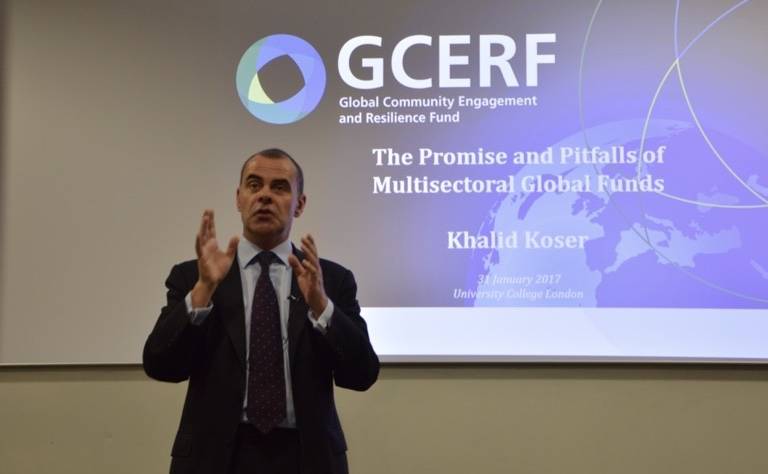The Promises and Pitfalls of Multisectoral Global Funds
22 February 2017
Julia Kreienkamp (GGI Research Assistant) on the GGI keynote lecture with Khalid Koser, Executive Director of the Global Community Engagement and Resilience Fund (GCERF).

Multisectoral Global Funds (MGFs) are emerging as innovative instruments for attracting, managing and disbursing resources on global priorities, such as sustainable development, health, climate change or violent extremism. A distinctive feature of MGFs is that they are governed and financed by a multi-stakeholder coalitions of national governments, international agencies, the private sector, and non-governmental organisations. MGFs operate independently and usually focus on a single issue or policy area.
Given this unique set-up and structure, MGFs have the potential to work more efficiently than most global and national donor agencies. However, there are serious limitations, including low democratic accountability, a tendency to support policy-making in isolation, and the risk of duplicating or substituting the work of other donors.
The Global Community Engagement and Resilience Fund (GCERF)
At a recent Global Governance Institute (GGI) keynote lecture, Khalid Koser, Executive Director of the Global Community Engagement and Resilience Fund (GCERF), reflected on how his organisation seeks to leverage the unique properties of MGFs. Established in 2014, GCERF is the first global effort to support community-level initiatives aimed at discouraging violent extremism. It was created in response to a major funding gap in this policy area, as many bilateral donors struggle to reach local level anti-radicalisation programmes and grassroots initiatives.
At the heart of GCERF's mandate is the belief that the causes, consequences and solutions to violent extremism are primarily local and that community-level knowledge and bottom-up action is key to addressing radicalisation. The initiatives supported by GCERF broadly fall into three categories: (1) raising awareness of violent extremism, (2) mobilising against radical messages and narratives, and (3) providing viable alternatives to violent extremism. In its first two years of operation, GCERF has supported communities in Bangladesh, Mali and Nigeria, and it will soon launch additional activities in Kenya, Kosovo and Myanmar. As GCERF's objective is to prevent violent extremism, it does not fund projects in regions that are already dangerously volatile (e.g. Northern Nigeria), focusing instead on those communities that are most at risk (e.g. the Nigerian Middle Belt).
Leveraging strengths…
MGFs can crystallise political traction around difficult and sensitive issue areas, such as violent extremism or HIV, and mobilise resources towards these issues by pooling (and thereby minimising) risks for donors. Because MGFs are apolitical and independent, they are able to engage a diverse mix of stakeholders and encourage debate across different sectors and policy communities. GCERF, for example, operates at the intersection of security and development, bringing together two communities with very different views on what violent extremism is and how it can best be addressed.
Perhaps most importantly, MGFs can channel spending on global public goods that would not receive enough funding if agents acted alone. As Koser explained, there are different reasons why bilateral agencies may not be able to fund certain projects, including political barriers. USAID, for example, has been expelled from Russia and some Latin American countries over allegations that it interfered with domestic politics. Other agencies simply lack the capacity to support local-level projects with small grants. For a donor such as the EU it is administratively much easier to make a large donation to a specialised foundation such as GCERF, which is then able to break it up into smaller grants to support community-based projects.
Finally, MGFs can use their economic muscle to achieve economies of scale in expertise and procurement. As an example, Koser pointed to the Global Alliance for Vaccines and Immunisation (GAVI) which has been able to procure vaccines at knock-down prices.
…and addressing weaknesses
The single-issue approach of MGFs can help building political momentum. However, it also risks promoting policy-making in isolation. For example, the Global Fund, one of the largest global health funders, has been criticised for focusing exclusively on AIDS, Tuberculosis and Malaria at the expense of strengthening the broader health system in recipient countries. Koser highlighted the need to promote national ownership in order to avoid policy-making in a vacuum. He also suggested that partnerships with governments and other donors are crucial to ensure that the work of MGFs are complementing - not duplicating or impeding - their activities.
MGFs, Koser argued further, have to be wary not to divert responsibility away from international organisations or national governments. This is why GCERF guards against any funding which is tied to a particular issue, project or initiative. According to Koser, such 'earmarked' funding would make the work of GCERF substitutive not additive: GCERF would simply be doing the work of others for them.
Although MGFs are independent, they have only weak democratic accountability. Therefore, Koser emphasised the need for strong governance mechanisms and a robust board in which all stakeholders are equally represented.
Finally, MGFs risk creating aid dependencies. In the case of the Global Fund, this was starkly illustrated in 2011, when the cancellation of its 11th funding round produced major uncertainty and undermined many national funding plans. To avoid creating similar dependencies, GCERF only provides funding for up to three years with a focus on promoting national ownership and local capacity building.
Conclusion
MGFs hold considerable promise as mechanisms to mobilise resources for difficult policy issues that are global in nature and would not receive sufficient funding otherwise. However, MGFs need to be carefully managed in order to avoid pitfalls such as incoherent policy-making, aid dependencies and duplication or diversion of responsibilities.
In the case of GCERF, there is an additional challenge: How do you measure success when it comes to countering violent extremism? Koser acknowledged that demonstrating the success of preventive work will always be difficult. Nevertheless, he argued, there is strong evidence that GCERF has picked the right model: Initial baseline studies confirm the importance of local factors - most of all the lack of employment opportunities - in causing violent extremism.
MGFs handle an increasingly large amount of money. The Global Fund, for instance, has received over USD 30 billion in contributions to date. Yet, according to Koser the academic literature on MGFs is surprisingly thin. More research is needed to understand how MGFs work, how they could work better and whether their model could be applied to other issue areas in the future.
 Close
Close


